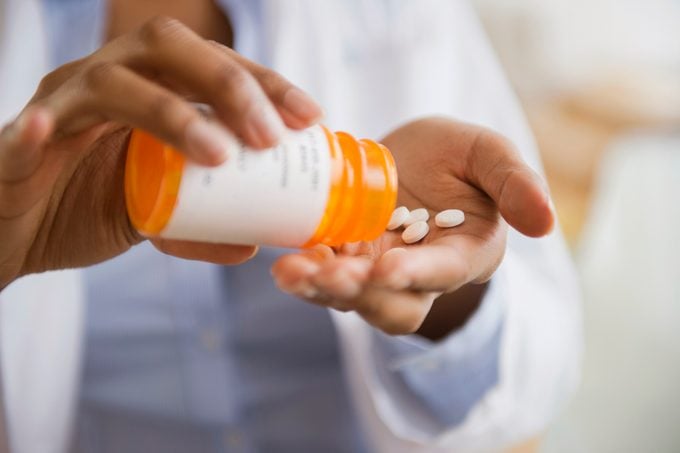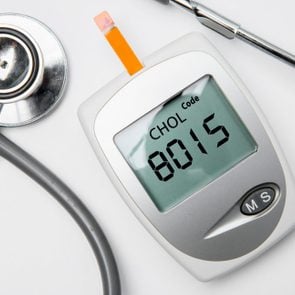These Are the Statin Side Effects You Should Know About
Updated: Apr. 14, 2021
Statins are one of the most widely prescribed and effective types of cholesterol-lowering medication. They also have a few potential side effects.
The power of statins
One of the biggest medical advances of the 20th century was the discovery of the cholesterol-lowering drugs known as statins. They continue to save lives. Studies show that they decrease major cardiovascular events—like heart attacks and stroke—by 25 to 45 percent, says Roger Blumenthal, MD, a spokesperson for the American Heart Association and director of the Johns Hopkins Ciccarone Center for the Prevention of Cardiovascular Disease in Baltimore.
Part of the power of statins lies in the fact that they cause few side effects.
“Generally, about 90 out of 100 people have no trouble with a stain,” says Dr. Blumenthal. And many of the remaining 10 percent can do well on a different statin. But although the chances of experiencing a problem are low, they’re not zero.
With at least 40 million people in the U.S. taking a statin, it’s important to know what the potential downside is.
What are statins?
The first statin, lovastatin (Mevacor), burst onto the scene in 1987. Today, patients can choose from several on the market, including atorvastatin (Lipitor), rosuvastatin (Crestor), and simvastatin (Zocor). The drugs all work in much the same way.
“Essentially, they decrease the production and enhance the removal of (LDL or ‘bad’) cholesterol from the bloodstream,” explains Dr. Blumenthal.
This type of cholesterol can build up in your arteries, eventually blocking blood vessels and increasing the risk of heart attacks, stroke, and death. Atherosclerotic disease has been the leading cause of death in the U.S. every year except for 1918, when it was overtaken by the influenza pandemic.
Today, about 78 million adults in the U.S. (37 percent) have high LDL levels. Getting LDL levels below 70 milligrams per deciliter (70 mg/dL) is one of the best things you can do for your health, according to guidelines from the American College of Cardiology and the American Heart Association.

Potential side effects of statins
Myalgia
Muscle pain (myalgia) is one of the most common side effects in patients right after starting statins, says Sameer Arora, MD, a cardiology fellow at the University of North Carolina at Chapel Hill. About five to 20 percent of people on statins report muscle pain.
Muscle pain is more likely to be related to statins if it affects both sides of the body and comes on within weeks or months of starting one of these drugs.
Certain statins, though, are less likely to be linked with myalgia. Those include pravastatin (Pravachol), fluvastatin (Lescol), rosuvastatin (Crestor), and pitavastatin (Livalo), says Dr. Blumenthal.
Vitamin D or coenzyme Q10 supplements are sometimes helpful, but not often, he adds. Don’t stop taking any medications without talking to your doctor or health care provider first.
Type 2 diabetes
Some people taking statins are at higher risk of developing type 2 diabetes. While this may sound like a pretty dramatic downside, those who develop type 2 may already be at risk for developing this common condition. What’s more, the risk appears to be relatively small, and statins are thought to cause one extra case of type 2 diabetes in every 255 people who take one of these drugs for four years, suggests a study in The Lancet.
You should weigh this against the already elevated risk of heart disease in people with high blood sugar or prediabetes. (Learn more about type 2 diabetes symptoms.)
Research published in Circulation: Cardiovascular Quality and Outcomes found 25 percent more cases of newly diagnosed type 2 diabetes in the statin group compared to those not taking a statin. The occurrence of new-onset diabetes went up when patients had one or more preexisting risk factors for type 2 diabetes.
However, this non-dose dependent possible side effect should not be a reason to avoid prescribing a statin—for every 54 newly diagnosed cases of diabetes in the study, 134 vascular events or deaths were prevented.
Memory and cognitive problems
Some people taking statins have reported feeling “unfocused” or “fuzzy.” But the symptoms, when they do occur, tend to be mild and it’s not clear that statins are the reason. As with myalgia, trying another statin or tweaking the dosage often clears the fog. And statins may actually reduce your risk of developing dementia over the long-term by slowing or preventing hardening of the arteries in the brain.
Problems with memory are also common with aging and, according to the Centers for Disease Control and Prevention (CDC), so is statin use. Between 2003 and 2012, 48 percent of adults 75 and over took statins versus only 17 percent of adults aged 40 to 59.
Liver damage
The Food and Drug Administration has determined that risk of “serious liver injury with statins is rare.” In 2012, the agency removed the requirement that all people taking statins have their liver function routinely monitored. Instead, patients should have their liver enzymes assessed before starting statins and if there are any unsettling symptoms like weakness, fatigue, or yellowing of the eyes or skin.
“Still, physicians tend to be cautious giving statins to people at high risk for liver disease, as statins have been known to affect liver function in some patients,” says Dr. Arora.
Other side effects
Patients have reported other statin side effects, but they’re not common. Some are relatively mild like headaches, fatigue, and indigestion. Tinkering with the drug or the dose can often solve the problem.
“Sometimes if you have indigestion we change the time of day you take the statin so there is food in the stomach as opposed to an empty stomach,” says Dr. Blumenthal.
Other uncommon side effects include hair loss, peripheral neuropathy (tingling in the hands or feet), acne, and pancreatitis. Statins may trigger a rare condition called anti-HMG-CoA reductase necrotizing autoimmune myositis. This is when the body’s immune system attacks the enzymes targeted by statins. It can cause the death of muscle cells, but likely only happens in people who already have a genetic predisposition to the condition.
(Here’s what you need to know about consuming grapefruit while taking statins.)
Who’s at risk for statin side effects?
Your age, genetic makeup, and other medications you take can affect your risk for statin side effects. For instance, certain antibiotics (cyclosporine and macrolide antibiotics) can increase the risk of side effects by causing higher levels of statins in your body.
The same is true of gemfibrozil (Lopid), which is used to lower cholesterol and triglyceride levels, and protease inhibitors, which treat HIV.
Age can also be a factor. “Older folks who tend to be on more medication are more likely to perceive side effects,” says Dr. Blumenthal. And certain gene mutations may affect how you react to statins. (Learn about medications that change urine color and other bizarre side effects.)
Are the side effects real?
Research presented at the American Heart Association’s 2020 annual meeting suggests that side effects can also occur in people taking a statin placebo. In other words, not a real statin.
In one study, about 60 people took a statin for four months, a placebo for four months, and no drugs at all for four months. All of the participants had taken statins in the past but discontinued them because of side effects. In the study, those who reported side effects from statins had the same side effects when taking a placebo.
What are we to make of this? “The study shows that a good number of people anticipate that they may derive side effects from a medication, but actually don’t have them or only have them when they are given a placebo,” says Dr. Blumenthal.
















